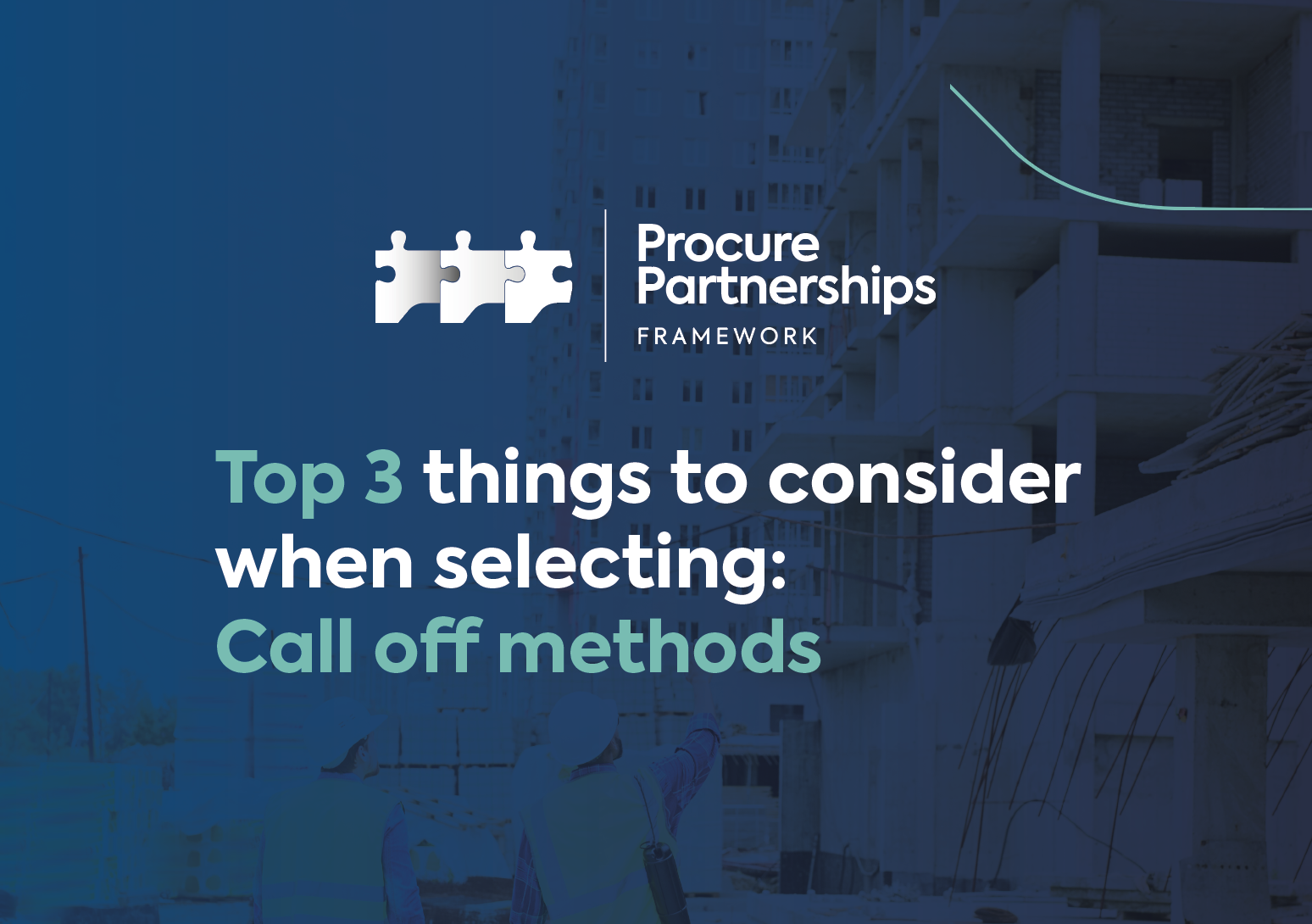Public sector procurement accounts for a third of the UK’s public spending, and in terms of construction, getting the call-off method right is crucial in ensuring project success.
Call-off methods define how contracts are procured and managed from inception to completion, and we often get asked by our clients, “which procurement route is the best?” There are various factors that come into play, and in this blog, Framework Director Faye Dolan uncovers the top three things to consider when selecting a call-off method, with commentary from Stuart Rogers, Director of Project Management at Muse.
Before diving into our key considerations, here’s a brief overview of three popular call-off methods:
Single Stage
In a typical single-stage project, several contractors submit tender returns. These will include a fixed price with all subcontractor-measured works packages priced in full. This approach can carry risk for both the contractor and the client, as it separates the design and construction process. However, if the design is sufficiently developed and realistic expectations on budget and project timelines are in place, this can be a fairly straightforward and successful approach. Keep in mind, if the design is under-developed it can leave scope for dispute due to modifications that may be required at a later date.
Two Stage
Two Stage tendering involves appointing a contractor early based on a preliminary price and a series of quality questions usually focused on the contractors’ relevant experience. Once a ‘preferred bidder’ is selected to be taken through to the second stage, the contractor then collaborates with the client during the design phase to finalise costs based on the complete design. This approach encourages collaboration and allows for early contractor input, which can be hugely beneficial for complex projects, reducing the risk of design modifications as contractor expertise is leveraged early.
We asked Director of Project Management at Muse, Stuart Rogers, about the deciding factors when selecting two stage or single stage. Stuart stated:
“At Muse, we specialise in long-term regeneration and partnership. The deciding factors often revolve around the project’s complexity and the maturity of the stakeholders. Two-stage procurement allows for early engagement of the contractor, which is advantageous for projects where design refinement and cost certainty are critical early on.”
Direct Award
In Direct Award projects, a contract is awarded to a contractor without a competitive tendering process. This can be done based on the contractor’s track record, specific expertise or an existing relationship. This method is particularly valuable to public sector bodies where funding comes with tight deadlines. This method eliminates lengthy tendering processes, enabling work to start almost immediately. If choosing a direct award route, we advise going through a framework to ensure value for money and performance management.
Now that we have an overview of each call-off method, let’s delve into the top three considerations when selecting a call-off method for your construction project:
Cost
The value of your project is a critical factor in determining the appropriate call-off method as high-value projects are usually more complex in design, scope and location. A city centre high-rise apartment block will typically require more detailed planning and will benefit from contractor expertise during the design phase. In this case, a two-stage procurement route would allow for a collaborative approach with the design and contractor teams which can help identify cost-saving opportunities and mitigate risks early on.
On the other hand, a single-stage procurement route might be more suitable for smaller projects where the scope is well-defined, and the need for early collaboration is less critical. In this case, single-stage procurement can be cost-effective as bidders usually compete on price. If you are planning on using the single-stage route, we would advise including as much design / survey (ideally RIBA 4 stage) information as you can within the bid documents.
Director of Project Management at Muse, Stuart, made an interesting point that cost should not be the only aspect to consider when selecting a call off method.
“Rather than just look at cost, at Muse we prefer to assess value. The value of early contractor engagement and partnership brings significant benefits to all developments. Whether that be working with the supply chain to interrogate design assumptions, de-risk a site, collaboratively procure early/enabling works packages, or complete detailed programme and logistics reviews. In addition, early contractor engagement through two-stage procurement can help ensure the agreed contract price has the best chance of being the same as the final account.”
Collaboration
The level of collaboration required for your project can significantly influence the choice of call-off method. When assessing the collaboration you require, you might consider whether your project is complex or innovative and could therefore benefit from contractor expertise. For example, do you have specific sustainability targets for your project, or will you be working on a heritage site? Contractors have entire delivery teams dedicated to their delivery areas, so you can feel confident that when you involve them early, they can pick up any potential issues before live construction starts.
Stuart added to this point, stating:
“Two stage procurement (and also direct negotiation) drives value into the procurement process, and can satisfy the needs of all stakeholders. We have had a recent example where a main contractor’s design manager influenced a complete change to the design philosophy of a building, making it simpler and more cost-effective to build.”
Whilst two stage projects are inherently more collaborative, single stage and direct award methods can facilitate collaboration if the contractor is chosen based on a proven ability to work closely with the client.
Value for Money
Ensuring that your project delivers value for money is a paramount concern, particularly when dealing with public funding. In our experience, value for money doesn’t just mean the lowest bid, it encapsulates the quality of the build, the level of support throughout the process, defect management, aftercare and in public sector projects, the long-term effects that the project has had on the community through social value add.
Single stage tendering can drive cost savings through competition, though it might not always capture the best value if the focus is solely on the lowest bid without considering the quality or long-term costs. In addition, prices may fluctuate if there are issues found with the design later down the line. On the other hand, two-stage tendering promotes more accurate cost and time estimates as it utilises contractor expertise and supply chain contacts earlier in the process. This collaborative approach can lead to better risk management, and a joint working relationship where better outcomes on quality, social value and support are in place.
Stuart shares how two stage procurement can provide value for money through social value delivery, stating:
“Social impact and sustainable outcomes are at the core of every development Muse are involved in. Our experience of Social Value in a two-stage process is extremely positive. A large amount of the social value delivered on a development is alongside the main contractor (where the largest spend is), and early contractor engagement allows a more significant amount of Social Value to be delivered at an earlier stage of the development.”
Direct Award routes can also provide value for money when effectively and closely managed. At Procure Partnerships Framework, we performance manage all of our contractor partners, ensuring they report monthly against various KPIs such as; cost management, design management, fair payment, social value delivery and defect management. This way, we can ensure that contractors are delivering what they promised, and if they don’t, it can affect their place on the entire framework. This reassures our framework users when procuring via direct award that we are monitoring the contractor’s ability to deliver on time and within budget, whilst striving for additional value for money through a comprehensive social value commitment.
Choosing the right call-off method for your construction project involves balancing cost, the need for collaboration, and programme pressures. High-value and complex projects can benefit significantly from the early contractor involvement and the collaborative nature of the two-stage method.
For more straightforward or smaller projects, single stage or direct award methods may be more appropriate, offering efficiency and simplicity. By carefully considering these factors, you can select the call-off method that best aligns with your project’s goals and constraints, setting the stage for successful delivery.
Still unsure which call-off method best suits your project? You can learn more by taking our 2 minute quiz, or get in touch with a member of the team for free commercial advice on 0333 577 7575.



